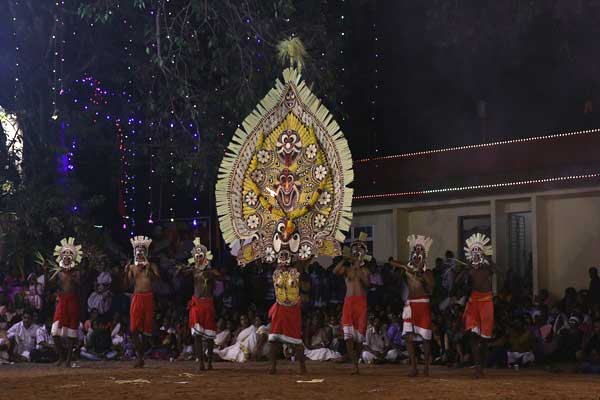 Kerala is a state famous for its rich culture and heritage. These rich traditions of Kerala are always reflected in its temple festivals too. Padayani is one such ritualistic performance at the Bhadrakali Temples of Kerala. Also known as Padeni, Padayani is a traditional folk dance of Kerala which is common in places like Kollam, Pathanamthitta, Alappuzha, and Kottayam. The word Padayani literally means rows of the army. A mix of music, dance, theatre, satire, facial masks and paintings, Padayani can be classified into Neelamperoor Padayani, Kadammanitta Padayani, and Othara Padayani. Neelamperoor Padayani is a mix of colors and cultures. It is conducted at Neelamperoor Palli Bhagavathy temple at Alappuzha. This festival usually falls in the month of August or September.
Kerala is a state famous for its rich culture and heritage. These rich traditions of Kerala are always reflected in its temple festivals too. Padayani is one such ritualistic performance at the Bhadrakali Temples of Kerala. Also known as Padeni, Padayani is a traditional folk dance of Kerala which is common in places like Kollam, Pathanamthitta, Alappuzha, and Kottayam. The word Padayani literally means rows of the army. A mix of music, dance, theatre, satire, facial masks and paintings, Padayani can be classified into Neelamperoor Padayani, Kadammanitta Padayani, and Othara Padayani. Neelamperoor Padayani is a mix of colors and cultures. It is conducted at Neelamperoor Palli Bhagavathy temple at Alappuzha. This festival usually falls in the month of August or September.
The Padayani in Neelamperoor stands unique with the display of deftly decorated effigies known as Kettukazhcha. At night there will be a colorful procession carrying the effigies of mythological characters like Bhima, Ravana, and Yakshi. The Kadammanitta Padayani is performed at Kadammanitta Devi temple in Pathanamthitta district. This ritual is practiced during the months of March or April, from the first day of the Malayalam month of Medam to 10th day, known as Pathamudayam. It pays homage to the splendor of the vicious masquerades of the Mother Goddess. The Othara Padayani is also performed during the months of March-April (Meenam and Medam of Malayalam months) at Puthukulangara Devi Temple, Othara, Pandalam, Pathanamthitta. Othara Padayani is a ten-day festival which is unique with the appearance of the Bhairavi Kolam made of 1001 painted areca nuts fronds on the tenth day.
 Arattu
Arattu Ashtami
Ashtami Kuthiyottam and Kettukazhcha
Kuthiyottam and Kettukazhcha Ettumanoor festival
Ettumanoor festival Kanathurkava Uthsavam
Kanathurkava Uthsavam Kodungallore Bharani
Kodungallore Bharani Kottuvillikavu Kumbhabharani
Kottuvillikavu Kumbhabharani Lokanarkavu Uthsavam
Lokanarkavu Uthsavam Thrissur Pooram
Thrissur Pooram Sivagiri matt
Sivagiri matt Thirunakkara Uthsavam
Thirunakkara Uthsavam Varkala arattu
Varkala arattu Uthralikavu Pooram
Uthralikavu Pooram Arattupuzha Pooram
Arattupuzha Pooram Vettikode Ayilyam
Vettikode Ayilyam Ambalapuzha arattu
Ambalapuzha arattu Attukal ponkala
Attukal ponkala Chittoor konganpada
Chittoor konganpada Guruvayoor festival
Guruvayoor festival Kappally kumbham thira
Kappally kumbham thira Koodal manickom
Koodal manickom Kalapathy Ratholsavam
Kalapathy Ratholsavam Mannaasrsala uthsavam
Mannaasrsala uthsavam Sabarimala shrine
Sabarimala shrine Sivarathri
Sivarathri Thiruvathira
Thiruvathira Vaikathashtami
Vaikathashtami Kottiyoor Festival
Kottiyoor Festival Aranmula Valla Sadhya
Aranmula Valla Sadhya Aranmula uthrittathi
Aranmula uthrittathi Adoor Gajamela
Adoor Gajamela Chottanikkara Makam
Chottanikkara Makam Haripad temple festival
Haripad temple festival Kodiyettu uthsavam
Kodiyettu uthsavam Kumaranalloor thrikarthika
Kumaranalloor thrikarthika Kuttikkol Thampuratty Theyyam
Kuttikkol Thampuratty Theyyam Nellikulangara vela
Nellikulangara vela Sharkara bharani and kaliyootu
Sharkara bharani and kaliyootu Sundareshwara temple festival
Sundareshwara temple festival Thrichambaram uthsavam
Thrichambaram uthsavam Theyyam
Theyyam Peruvanam Pooram
Peruvanam Pooram Anayoottu
Anayoottu